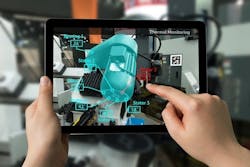Drive HVAC Efficiency with Internet of Things Functionality
The Internet of Things, a system of smart devices that communicate with each other, could drive down your facility’s HVAC energy spend – if it’s implemented intelligently. IoT-enabled HVAC usually takes the form of smart thermostats and sensors monitoring environmental changes and communicating back and forth with your HVAC equipment, dynamically adjusting temperature as needed.
simple thermostats for many occupants, the GSA notes.
Deriving maximum benefit from adding IoT devices to your HVAC setup requires careful implementation. Consider these four tips to maximize the usefulness of your IoT-enabled HVAC system.
Trending: Microsoft Azure IoT for Smart Buildings at BOMA 2018
1) Choose a Flexible System
Opt for architecture and infrastructure that are scalable and based on open-source technology, recommends Hurwitz & Associates, a technology consulting and research firm.
The IoT core platform that will manage data and convey commands to your HVAC system should be agnostic to platforms and protocols – proprietary technology could throw unnecessary hurdles into your path. The system should also be able to leverage data from a variety of sensor types to give you the best possible picture of your HVAC system’s function.
Related: Is Your HVAC System Spreading Thirdhand Smoke?
“A flexible IoT core platform must be designed to accommodate change,” Hurwitz & Associates notes. “This is in stark contrast to traditional IoT solutions that are purpose-built based on single use cases. When an IoT solution is purpose-built, it becomes rigid and unable to adapt to changing technologies and business requirements.”
2) Explore Use-Driven Technology
Some IoT systems incorporate user feedback on space conditions to adjust temperatures as needed. Over time, such systems learn user preferences to maximize both comfort and energy savings.
“Thermostats control the condition of a space to a given temperature, but the temperature setting does not necessarily translate to occupant comfort,” the GSA writes in its exploration of socially driven HVAC optimization, a type of use-driven technology that adjusts space conditions based on ongoing occupant feedback.
“The temperature at which a single individual is comfortable varies according to conditions such as humidity level, airflow, sunlight, heat from office equipment and drafts, as well as the individual’s activity level. Thermostats can over- or under-heat or cool a space, resulting in wasted energy, occupant discomfort and reduced productivity.”
Read also: Machine Learning: 5 Steps to Optimize Your Facility with Data Analytics
Compounding the problem in large buildings is the unavailability of even simple thermostats for many occupants, the GSA notes. If an occupant in one of these buildings is uncomfortable, they can’t just adjust the thermostat – they have to initiate a work order with the facilities staff and wait for adjustments. IoT technologies, particularly those with use-driven functionality, can react faster; some, like the socially driven HVAC optimization software, will gradually return spaces to conditions that save more energy after the immediate comfort problem is satisfied.
3) Accommodate Wiggle Room
If use-driven temperature adjustment isn’t feasible, consider at least allowing occupants to adjust the temperature in their space within a tolerable band. Set a maximum power consumption limit, but allow temperatures to fluctuate a few degrees so that occupants can make their spaces somewhat more comfortable.
4) Don’t Neglect Security
Security is the No. 1 hurdle for Internet of Things growth, according to Gartner Research. Devices are a hacker’s dream – they must make real-time bi-directional Internet connections, a type of communication that’s tough to protect, and security for IoT devices is not nearly as advanced as protocols are for servers, computers and smartphones.
Do Your IoT Devices Risk a Security Breach?
Your IoT vendor should be able to discuss how they’ll set up a secure data stream network for device communication, explains PubNub, a secure data stream network and API provider. It should include, at the minimum, these five concepts:
- Devices that only make outbound connections, as any device on the internet with an open inbound port will be attacked sooner or later
- End-to-end encryption to protect data streaming between devices – this way, the network provides the security throughout the entire transmission, alleviating the requirement for the manufacturer to build in encryption
- Token-based access control, which grants access to specific data channels to the relevant devices instead of overwhelming all of the end devices with every signal – this also eliminates the inefficiency and insecurity of asking all end devices to just filter out irrelevant topics
- Device status monitoring so you’re alerted whenever a sensor or device disappears or stops sending or receiving data, which could mean tampering, an outage or another issue
- User-friendly setup and upgrades so it’s simple and quick to keep all devices up to date on software and firmware
Here are two hand-picked articles to read next:
About the Author
Janelle Penny
Editor-in-Chief at BUILDINGS
Janelle Penny has been with BUILDINGS since 2010. She is a two-time FOLIO: Eddie award winner who aims to deliver practical, actionable content for building owners and facilities professionals.

